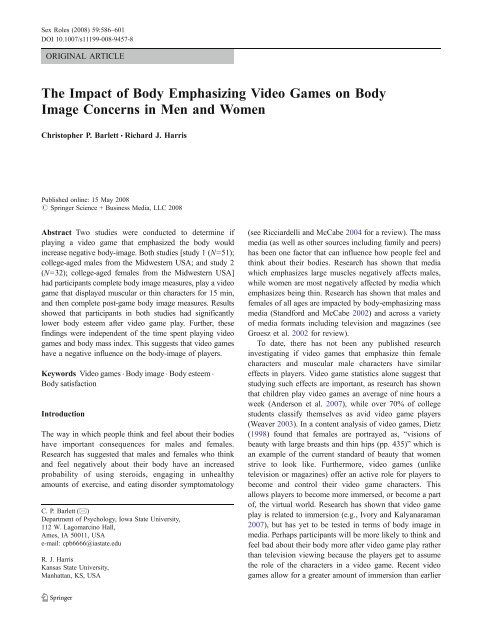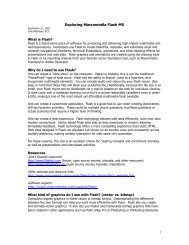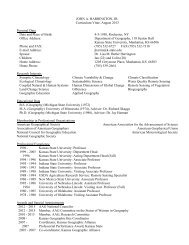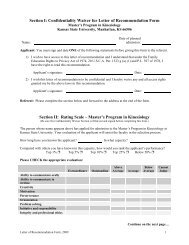The Impact of Body Emphasizing Video Games on Body Image ...
The Impact of Body Emphasizing Video Games on Body Image ...
The Impact of Body Emphasizing Video Games on Body Image ...
- No tags were found...
Create successful ePaper yourself
Turn your PDF publications into a flip-book with our unique Google optimized e-Paper software.
Sex Roles (2008) 59:586–601 587video games because the more modern video games allowthe players to create characters in great detail, includinghair color, eye color, face shape, hair style, height, weight,muscularity level, and so forth. Thus, in more recent videogames, players have the ability to create players that closelyresemble their actual or ideal appearance, which mayfurther the amount <str<strong>on</strong>g>of</str<strong>on</strong>g> immersi<strong>on</strong> in the game.Two studies were c<strong>on</strong>ducted in order to determine ifplaying a video game that emphasized the male or femalebody would increase negative body-images in both maleand female participants. Both studies utilized similarmethodologies and sampled college-aged participants,who are especially at risk for eating disorders. Both studieshad participants complete baseline measures <str<strong>on</strong>g>of</str<strong>on</strong>g> how theythink and feel about their body, played a body-emphasizingvideo game for fifteen minutes, and then completed postgamebody image measures. Overall, it was predicted thatmales and females would feel worse about their body afterplaying these games because <str<strong>on</strong>g>of</str<strong>on</strong>g> the frequent depicti<strong>on</strong>s <str<strong>on</strong>g>of</str<strong>on</strong>g>muscular male and thin female characters.Negative <str<strong>on</strong>g>Body</str<strong>on</strong>g>-<strong>Image</strong>sC<strong>on</strong>sistent across various psychological disorders (such asanorexia nervosa, bulimia, and muscle dysmorphia) arenegative feelings about the body, or a negative body-image.For the purposes <str<strong>on</strong>g>of</str<strong>on</strong>g> the current research, the operati<strong>on</strong>aldefiniti<strong>on</strong> <str<strong>on</strong>g>of</str<strong>on</strong>g> a negative body-image is “a way <str<strong>on</strong>g>of</str<strong>on</strong>g> thinkingand feeling about <strong>on</strong>e’s body that negatively influences thepers<strong>on</strong>’s self-esteem, body esteem, and body satisfacti<strong>on</strong>(Barlett et al. 2005, pp 877).” Using this definiti<strong>on</strong>, researchhas shown that exposure to body emphasizing mass medianegatively impacts the viewer’s self-esteem, body esteem,and body satisfacti<strong>on</strong> (Fawkner and McMurray 2002). Each<str<strong>on</strong>g>of</str<strong>on</strong>g> these three c<strong>on</strong>structs is related to <strong>on</strong>e another, butc<strong>on</strong>ceptualized differently. <str<strong>on</strong>g>Body</str<strong>on</strong>g> esteem is defined as theaffective, or feeling, comp<strong>on</strong>ent about the body (Franzoiand Shields 1984). <str<strong>on</strong>g>Body</str<strong>on</strong>g> satisfacti<strong>on</strong> is the cognitivecomp<strong>on</strong>ent and is associated with negative thoughts aboutthe body (Baranowski et al. 2003). Finally, according toRosenberg (1965), self-esteem is defined as an overallfeeling <str<strong>on</strong>g>of</str<strong>on</strong>g> self-worth and happiness with your self. Selfesteemis not specifically isolated to self-worth about thebody, but research has shown that body esteem and bodysatisfacti<strong>on</strong> are significantly correlated with self-esteem(Barlett et al. 2005), which suggests that happiness with thebody is just <strong>on</strong>e porti<strong>on</strong> <str<strong>on</strong>g>of</str<strong>on</strong>g> self-esteem.In additi<strong>on</strong> to body esteem and body satisfacti<strong>on</strong>, drivefor muscularity and positive attitudes towards muscularityare important variables for men. Ricciardelli and McCabe(2004) c<strong>on</strong>ceptualize the pursuit <str<strong>on</strong>g>of</str<strong>on</strong>g> muscularity as anybehaviors that are indicative <str<strong>on</strong>g>of</str<strong>on</strong>g> having a negative bodyimage, such as steroid usage. Thus, the drive for muscularityshould be related to body dissatisfacti<strong>on</strong> after sociallycomparing with “ideal” media images. Positive attitudestowards muscularity is operati<strong>on</strong>alized as thoughts andfeelings related to muscularity. One may have positiveattitudes towards muscularity and then subsequently takesteroids because thinking and feeling that muscles are goodmay subsequently influence social comparis<strong>on</strong> processes.Research using both these scales (Hatoum and Belle 2004)found that positive attitudes toward muscularity and drivefor muscularity are both related to pressure from the massmedia to change <strong>on</strong>e’s body.<str<strong>on</strong>g>The</str<strong>on</strong>g> extent to which <strong>on</strong>e thinks and feels about theirbody and how <strong>on</strong>e feels about their overall self-worth hasbeen shown to be linked to psychological and behavioralnegative outcomes. For example, research has shown thathaving a negative body-image is positively correlated withpsychological disorders, such as feelings <str<strong>on</strong>g>of</str<strong>on</strong>g> depressi<strong>on</strong>(Cafri et al. 2002) and anxiety (Tantleff-Dunn andThomps<strong>on</strong> 2000). Having a negative body-image is alsorelated to various behavioral outcomes, such as excessivelyexercising (Ricciardelli et al. 2000), dieting (Hausenblasand Fall<strong>on</strong> 2002), and having a higher probability <str<strong>on</strong>g>of</str<strong>on</strong>g> usingsteroids (McCabe and Ricciardelli 2004). <str<strong>on</strong>g>The</str<strong>on</strong>g>se types <str<strong>on</strong>g>of</str<strong>on</strong>g>behaviors <str<strong>on</strong>g>of</str<strong>on</strong>g>ten lead to, or are related to, a variety <str<strong>on</strong>g>of</str<strong>on</strong>g> lifethreateningillnesses, such as eating disorders.Since negative body-images are related to serious psychologicaland behavioral acti<strong>on</strong>s, an important questi<strong>on</strong> is:Where do these negative body-images come from? <str<strong>on</strong>g>The</str<strong>on</strong>g>literature has shown that peers and family (Kearney-Cooke2002; Murray et al. 1995; Phares et al. 2004) are two importantsources <str<strong>on</strong>g>of</str<strong>on</strong>g> where individuals get a sense for howthey should think and feel about their body. Another source<str<strong>on</strong>g>of</str<strong>on</strong>g> negative body-image attainment is the mass media.Research has shown that a variety <str<strong>on</strong>g>of</str<strong>on</strong>g> mass media outletscan impact <strong>on</strong>e’s body-image, including magazine pictures(Frederick et al. 2005) and televisi<strong>on</strong> commercials (Sticeand Shaw 1994).Negative <str<strong>on</strong>g>Body</str<strong>on</strong>g>-<strong>Image</strong>s in Females by the Mass Media<str<strong>on</strong>g>The</str<strong>on</strong>g> majority <str<strong>on</strong>g>of</str<strong>on</strong>g> work <strong>on</strong> negative body-images induced bythe mass media has used female samples, and research hasshown that after exposure to thin female models, womenhave more <str<strong>on</strong>g>of</str<strong>on</strong>g> a negative body-image and every comp<strong>on</strong>ent<str<strong>on</strong>g>of</str<strong>on</strong>g> a negative body-image is impacted. Specifically, researchhas shown that women will have lower body satisfacti<strong>on</strong>(Hargreaves and Tiggeman 2002), body esteem (Ogden andMundray 1996), and self-esteem (Champi<strong>on</strong> and Furnham1999) after viewing thin female models. Further, it has beenshown that after viewing thin female media depicti<strong>on</strong>s,women will have more eating disorder symptomatology(Stice and Shaw 1994) and anxiety (Lin and Kulik 2002).<str<strong>on</strong>g>The</str<strong>on</strong>g>se results are robust, as research has shown that these
588 Sex Roles (2008) 59:586–601effects are generalizable across multiple media formats,including celebrity pictures (King et al. 2000), televisi<strong>on</strong>programs (Stice and Shaw 1994), and even Barbie (Dittmaret al. 2006).Groesz et al. (2002) c<strong>on</strong>ducted a meta-analysis <strong>on</strong> howfemale participants felt about their body after beingexperimentally shown thin female models across multiplemedia formats (e.g., commercials, slides, and magazines).Results showed that across 43 effect size estimates femaleparticipants who were experimentally shown media <str<strong>on</strong>g>of</str<strong>on</strong>g> thinfemale models felt significantly worse about their bodiesthan those who were not exposed to such stimuli (d=−.31;negative values indicate a more negative body-image).Negative <str<strong>on</strong>g>Body</str<strong>on</strong>g>-<strong>Image</strong>s in Males by the Mass MediaRecently, there has been a focus <strong>on</strong> how males resp<strong>on</strong>d tomass media images in relati<strong>on</strong> to feelings and thoughtsabout their body. Unlike the stimulus that increasesnegative body-images in females, research has shown thatthe “ideal” body image for men is muscular and that malesare negatively impacted by muscular stimuli. Despite thedifference between men and women <strong>on</strong> what stimuliincreases their negative body-image, research has shownthat like women, men will have a decrease in their bodyesteem (Leit et al. 2002), body satisfacti<strong>on</strong> (Agliata andTantleff-Dunn 2004), and self-esteem (Palladino andPritchard 2003) after viewing muscular stimuli in the massmedia. <str<strong>on</strong>g>The</str<strong>on</strong>g>se results are robust, as research has shown thattelevisi<strong>on</strong> commercials (Agliata and Tantleff-Dunn 2004),magazine pictures (Hausenblas et al. 2003; Humphreys andPaxt<strong>on</strong> 2004), and even acti<strong>on</strong> figures (Barlett et al. 2005;Barlett et al. 2006) have this effect.Recently, two meta-analyses c<strong>on</strong>ducted by Barlett et al.(2008) found that across 93 effect size estimates, males whowere exposed to a muscular stimuli had a significantlyhigher negative body-image (d=−.20; negative valuesindicate more <str<strong>on</strong>g>of</str<strong>on</strong>g> a negative body-image). <str<strong>on</strong>g>The</str<strong>on</strong>g>se resultswere robust to which media format, how muscular the malestimuli was, and across the different c<strong>on</strong>structs that makeup a negative body-image, including body satisfacti<strong>on</strong> andbody esteem.<str<strong>on</strong>g>The</str<strong>on</strong>g>oretical Frameworks<str<strong>on</strong>g>The</str<strong>on</strong>g> tripartite influence model (Shr<str<strong>on</strong>g>of</str<strong>on</strong>g>f and Thomps<strong>on</strong> 2006;Smolak et al. 2005) proposes that three socioculturalinfluences (parents, peers, and the mass media) are directlyrelated to body dissatisfacti<strong>on</strong>. Once body dissatisfacti<strong>on</strong> isincreased due to <strong>on</strong>e (or more) <str<strong>on</strong>g>of</str<strong>on</strong>g> the aforementi<strong>on</strong>edsociocultural influences, it is predicted that behavioraloutcomes (e.g., bulimia and steroid usage) will increase.Also, the three sociocultural factors also have an indirectlink to behavioral outcomes. Internalizati<strong>on</strong> <str<strong>on</strong>g>of</str<strong>on</strong>g> societalstandards and appearance comparis<strong>on</strong> are both predicted tomediate this relati<strong>on</strong>ship. Thus, the reas<strong>on</strong> why the massmedia negatively influences self-image is because peoplewill <str<strong>on</strong>g>of</str<strong>on</strong>g>ten compare their own body to the image they areviewing (appearance comparis<strong>on</strong> process) or internalize thestandards <str<strong>on</strong>g>of</str<strong>on</strong>g> “beauty” that the stimuli represent. Overall,those who view appearance-related mass media are predictedto have lower body satisfacti<strong>on</strong> and will comparetheir own body to these depicti<strong>on</strong>s. <str<strong>on</strong>g>The</str<strong>on</strong>g>n, either directly orindirectly (through the aforementi<strong>on</strong>ed mediated pathways),people will have an increase probability <str<strong>on</strong>g>of</str<strong>on</strong>g> performingbehavioral acti<strong>on</strong>s that reflect the c<strong>on</strong>sequences <str<strong>on</strong>g>of</str<strong>on</strong>g> feelingbad about <strong>on</strong>e’s body (e.g., steroid usage, bulimia).Interestingly, this model does not make any predicti<strong>on</strong>sabout positive attitudes toward muscularity. However, wec<strong>on</strong>ceptualized drive for muscularity to be similar tobehavioral intenti<strong>on</strong>s to engage in negative health relatedbehaviors (e.g., steroid usage), which is c<strong>on</strong>sistent withsimilar theoretical frameworks (Ricciardelli and McCabe2004).As the aforementi<strong>on</strong>ed descripti<strong>on</strong> <str<strong>on</strong>g>of</str<strong>on</strong>g> the TripartiteInfluence Model states, there are no predicti<strong>on</strong>s made aboutthe role <str<strong>on</strong>g>of</str<strong>on</strong>g> pers<strong>on</strong>ological variables that are related to how<strong>on</strong>e thinks and feels about <strong>on</strong>e’s body. For instance, thismodel does not posit that body mass index or the number <str<strong>on</strong>g>of</str<strong>on</strong>g>hours spent viewing the mass media moderates the overallrelati<strong>on</strong>ship. Thus, people who are fat, thin, tall, short,muscular, or n<strong>on</strong>-muscular are all predicted to be influencedby the immediate exposure <str<strong>on</strong>g>of</str<strong>on</strong>g> “ideal” images in the massmedia. However, a model by Cafri et al. (2003) posits thatcertain biological factors (e.g., age, puberty timing)moderate the relati<strong>on</strong>ship between sociocultural factorsand body dissatisfacti<strong>on</strong>. Thus, testing moderating variablesis important in the current study.Study 1Overview <str<strong>on</strong>g>of</str<strong>on</strong>g> the Current Study<str<strong>on</strong>g>The</str<strong>on</strong>g> purpose <str<strong>on</strong>g>of</str<strong>on</strong>g> the current study was to determine ifplaying a video game that emphasized the muscular malebody would increase negative body-images in males. Based<strong>on</strong> the Tripartite Influence Model and the past literature, thefollowing hypotheses were derived:H1: <str<strong>on</strong>g>The</str<strong>on</strong>g>re will be a decrease in body esteem, bodysatisfacti<strong>on</strong>, positive attitudes toward muscularity,and an increase in the pursuit <str<strong>on</strong>g>of</str<strong>on</strong>g> muscularity afterplaying a video game that emphasizes muscles.Specifically, this hypothesis is a test <str<strong>on</strong>g>of</str<strong>on</strong>g> the TripartiteInfluence Model and the past literature which has shown
590 Sex Roles (2008) 59:586–601character. This allowed for a higher degree <str<strong>on</strong>g>of</str<strong>on</strong>g> immersi<strong>on</strong>because the character that the player is c<strong>on</strong>trolling wassupposed to have skin and facial features like the participant,have a similar height and weight as the participant, and evenhave the participant’s name as the characters name.Although this video game and video game system werenot the most modern at the time <str<strong>on</strong>g>of</str<strong>on</strong>g> the data collecti<strong>on</strong>, thisgame allowed for the optimal amount <str<strong>on</strong>g>of</str<strong>on</strong>g> experimentalc<strong>on</strong>trol, allowed the participants to create themselves as awrestler, and was a relatively simple game for theparticipants to play. Other modern video games and videogame systems did not allow for all <str<strong>on</strong>g>of</str<strong>on</strong>g> the aforementi<strong>on</strong>edadvantages to be utilized.Questi<strong>on</strong>naires <str<strong>on</strong>g>The</str<strong>on</strong>g> first questi<strong>on</strong>naire was the <str<strong>on</strong>g>Body</str<strong>on</strong>g>Esteem Scale (Franzoi and Shields 1984), which was usedto assess state body esteem. This scale c<strong>on</strong>tains 35 items,however, <strong>on</strong>ly 33 are applicable to men. This measureutilized a 1 (have str<strong>on</strong>g negative feelings) to 5 (have str<strong>on</strong>gpositive feelings) Likert scale, with higher numbersindicating higher body esteem. <str<strong>on</strong>g>The</str<strong>on</strong>g> questi<strong>on</strong>s askedparticipants to resp<strong>on</strong>d to how they feel about certainparts <str<strong>on</strong>g>of</str<strong>on</strong>g> their body (i.e., biceps, arms) and certain behaviorsindicative <str<strong>on</strong>g>of</str<strong>on</strong>g> good physical stature (i.e., physicalcoordinati<strong>on</strong>, physical stamina). Franzoi and Shields(1984) factor analyzed the items <strong>on</strong> this scale and foundthat, for men, the items significantly loaded <strong>on</strong>to threefactors. <str<strong>on</strong>g>The</str<strong>on</strong>g> first is the Physical Attractiveness (PA)subscale, which c<strong>on</strong>tained 11 items, which assesses howphysically attractive participants feel about various parts <str<strong>on</strong>g>of</str<strong>on</strong>g>their body (e.g., face). <str<strong>on</strong>g>The</str<strong>on</strong>g> sec<strong>on</strong>d subscale is the PhysicalC<strong>on</strong>diti<strong>on</strong> (PC) scale, which c<strong>on</strong>tains 13 items to assesshow participants feel about the parts <str<strong>on</strong>g>of</str<strong>on</strong>g> their body whichare related to being in good shape (e.g., appearance <str<strong>on</strong>g>of</str<strong>on</strong>g>stomach, health, weight). <str<strong>on</strong>g>The</str<strong>on</strong>g> final subscale is the Upper<str<strong>on</strong>g>Body</str<strong>on</strong>g> Strength (UBS) scale, which c<strong>on</strong>tains nine items toassess how participants feel about various parts <str<strong>on</strong>g>of</str<strong>on</strong>g> the bodythat are related to upper body strength (e.g., body build,muscular strength). <str<strong>on</strong>g>The</str<strong>on</strong>g> range <str<strong>on</strong>g>of</str<strong>on</strong>g> possible total scores <strong>on</strong>the entire scale is 33–165. Reliability analyses showed thatthe BES was moderately reliable at baseline (α=.58) andreliable at time 2 (α=.89). It is predicted that the lowerreliability <str<strong>on</strong>g>of</str<strong>on</strong>g> the BES at baseline is a functi<strong>on</strong> <str<strong>on</strong>g>of</str<strong>on</strong>g> the unreliablePA subscale at baseline (α=−.07), while the other twosubscales were reliable (α PC =.89 and α UBS =.74). However,all <str<strong>on</strong>g>of</str<strong>on</strong>g> the subscales were reliable at time 2 (α PC =.86, α PA =.66,and α UBS =.86).<str<strong>on</strong>g>The</str<strong>on</strong>g> sec<strong>on</strong>d measure was the Swansea MuscularityAttitudes Questi<strong>on</strong>naire (SMAQ; Edwards and Launder2000). This is a 20-item measure that assesses attitudestoward muscularity which uses a 1 (definitely) to 7(definitely not) Likert scale, with higher numbers indicatingpoorer attitudes toward muscularity. This is a state measureand the questi<strong>on</strong>s ask the participants to resp<strong>on</strong>d to avariety <str<strong>on</strong>g>of</str<strong>on</strong>g> items assessing how they think, feel, and wouldbehave in certain scenarios. For example, <strong>on</strong>e item states, “Ifeel bad about my body when I do not feel very big ormuscular.” This scale is divided into two subscales, based<strong>on</strong> the results from a factor analysis (Edwards and Launder2000). <str<strong>on</strong>g>The</str<strong>on</strong>g> first subscale is the Positive Attitudes towardMuscularity (PAM), which is a ten-item subscale. Anexample item includes, “Being muscular gives me c<strong>on</strong>fidence.”<str<strong>on</strong>g>The</str<strong>on</strong>g> sec<strong>on</strong>d subscale is the Drive for Muscularity(DFM), which is a ten-item subscale. An example itemincludes, “I aim to further develop my physique.” <str<strong>on</strong>g>The</str<strong>on</strong>g> totalrange <str<strong>on</strong>g>of</str<strong>on</strong>g> possible scores <strong>on</strong> the entire scale is 20–140. Forthe purposes <str<strong>on</strong>g>of</str<strong>on</strong>g> the current study, both the PAM and DFMmeasured aspects <str<strong>on</strong>g>of</str<strong>on</strong>g> body satisfacti<strong>on</strong>. Specifically, theDFM is similar to the drive for thinness in females and thePAM measures both thoughts and feelings about muscularity.Reliability analyses showed that the SMAQ had acceptablereliability at baseline (α=.94) and time 2 (α=.96).<str<strong>on</strong>g>The</str<strong>on</strong>g> PAM and the DFM had acceptable reliabilities at baseline(α PAM =.91 and α DFM =.89) and at time 2 (α PAM =.94and α DFM =.92).<str<strong>on</strong>g>The</str<strong>on</strong>g> third measure was the Male <str<strong>on</strong>g>Body</str<strong>on</strong>g> <strong>Image</strong> and EsteemScale (MBIES; Markunas et al. 2003), which measures thebody esteem in men. Unlike the BES, this scale assesseshow men feel about certain statements, which are related totheir body, rather than how an individual feels about certainbody parts or acti<strong>on</strong>s. One item reads, “I like to have mypicture taken.” This scale c<strong>on</strong>sists <str<strong>on</strong>g>of</str<strong>on</strong>g> 20 items that arescored <strong>on</strong> a 1 (not a characteristic) to 7 (extremecharacteristic) Likert scale, with higher scores beingindicative <str<strong>on</strong>g>of</str<strong>on</strong>g> higher body esteem. <str<strong>on</strong>g>The</str<strong>on</strong>g> total range possible<strong>on</strong> this scale is 20–140.Past research which has used the MBIES (Barlett et al.2005) has treated the items <strong>on</strong> the MBIES as a statemeasure. However, closer examinati<strong>on</strong> <str<strong>on</strong>g>of</str<strong>on</strong>g> certain itemsrevealed that some <str<strong>on</strong>g>of</str<strong>on</strong>g> the items are assessing state and someare assessing trait male body esteem. <str<strong>on</strong>g>The</str<strong>on</strong>g> state items askquesti<strong>on</strong>s that could change as a functi<strong>on</strong> <str<strong>on</strong>g>of</str<strong>on</strong>g> exposure to astimulus. For instance, “I’m c<strong>on</strong>tent with the way I look”can change as a functi<strong>on</strong> <str<strong>on</strong>g>of</str<strong>on</strong>g> exposure to a stimulus (e.g., amuscular model in a magazine). Other items were writtensuch that they should not change as a functi<strong>on</strong> <str<strong>on</strong>g>of</str<strong>on</strong>g> exposureto a stimulus, which suggests that some <str<strong>on</strong>g>of</str<strong>on</strong>g> the items asassessing trait body esteem. For example, <strong>on</strong>e item read, “Igo to the gym enough so that the employees know me byname.” Independent <str<strong>on</strong>g>of</str<strong>on</strong>g> whether the participant just saw amuscular male model <strong>on</strong> a magazine or not, that should notaffect the extent to which people actively go the gymenough such that the employees know the participant byname. <str<strong>on</strong>g>The</str<strong>on</strong>g>refore, the MBIES was separated into twosubscales. <str<strong>on</strong>g>The</str<strong>on</strong>g> first was a state measure <str<strong>on</strong>g>of</str<strong>on</strong>g> male bodyesteem, which c<strong>on</strong>tained ten items, and the sec<strong>on</strong>d was a
Sex Roles (2008) 59:586–601 591trait measure <str<strong>on</strong>g>of</str<strong>on</strong>g> male body esteem, which also c<strong>on</strong>tainedten items. <str<strong>on</strong>g>The</str<strong>on</strong>g> Likert scale and interpretati<strong>on</strong> <str<strong>on</strong>g>of</str<strong>on</strong>g> the resultsfrom each subscale are identical to the original MBIES.Reliability analyses showed that the MBIES (entire scale)had acceptable reliability at baseline (α=.88) and time 2(α=.91). When the MBIES was divided into the state andtrait porti<strong>on</strong>s, the results showed that both had acceptablereliabilities at baseline (α state =.79 and α trait =.87) and attime 2 (α state =.88 and α trait =.83).<str<strong>on</strong>g>The</str<strong>on</strong>g> fourth measure was a demographic questi<strong>on</strong>naire.This measure assessed demographic variables, such as age,year in school, and ethnicity. Also assessed was height andweight <str<strong>on</strong>g>of</str<strong>on</strong>g> the participants, which was used to calculate theirBMI, based <str<strong>on</strong>g>of</str<strong>on</strong>g>f <str<strong>on</strong>g>of</str<strong>on</strong>g> the Nati<strong>on</strong>al Institute <str<strong>on</strong>g>of</str<strong>on</strong>g> Health’s website(http://www.nhlbisupport.com/bmi/). Finally, amount <str<strong>on</strong>g>of</str<strong>on</strong>g>video game play was assessed by asking participants how<str<strong>on</strong>g>of</str<strong>on</strong>g>ten they played video games <strong>on</strong> every day <str<strong>on</strong>g>of</str<strong>on</strong>g> the week,<strong>on</strong> average. <str<strong>on</strong>g>The</str<strong>on</strong>g>se items were summed to get an assessment<str<strong>on</strong>g>of</str<strong>on</strong>g> how <str<strong>on</strong>g>of</str<strong>on</strong>g>ten the participants played video games weekly.<str<strong>on</strong>g>The</str<strong>on</strong>g> final questi<strong>on</strong>naire was a suspiciousness questi<strong>on</strong>naire.Due to the highly publicized nature <str<strong>on</strong>g>of</str<strong>on</strong>g> video gameeffects and the heavy emphasis <strong>on</strong> body image questi<strong>on</strong>s,two questi<strong>on</strong>s were asked to determine if the participantshad been told about the hypotheses <str<strong>on</strong>g>of</str<strong>on</strong>g> the current studyprior to being in the study, and if they were able to infer thepredicti<strong>on</strong>s <str<strong>on</strong>g>of</str<strong>on</strong>g> the current study based <strong>on</strong> the questi<strong>on</strong>sasked <strong>on</strong> the scales. Analysis <str<strong>on</strong>g>of</str<strong>on</strong>g> this questi<strong>on</strong>naire revealedn<strong>on</strong>e <str<strong>on</strong>g>of</str<strong>on</strong>g> the participants knew the purposes <str<strong>on</strong>g>of</str<strong>on</strong>g> the currentstudy prior to being debriefed.ProcedureUp<strong>on</strong> completi<strong>on</strong> <str<strong>on</strong>g>of</str<strong>on</strong>g> the informed c<strong>on</strong>sent and experimentalcredit slips, participants were randomly assigned to play thevideo game in either the muscular (n=27) or n<strong>on</strong>-muscular(n=24) c<strong>on</strong>diti<strong>on</strong>. Participants were given all baselinebody-image measures to complete by either a male orfemale research assistant. <str<strong>on</strong>g>The</str<strong>on</strong>g>se measures included theBES, SMAQ, and MBIES. Once these measures werecompleted, participants were then given an instructi<strong>on</strong> sheetwhich informed them how to create a wrestler to resemblethe appearance <str<strong>on</strong>g>of</str<strong>on</strong>g> the participants. Specifically, this sheetinstructed participants to change a default looking wrestlerto have the same skin color, hair color, hair cut, facial hair,height, weight, face shape, and muscle mass as they have.After the basic bodily features were changed to resemblethe participant, the instructi<strong>on</strong> sheet had participants dressthe character such that the character was not wearing a shirtand had short wrestling shorts <strong>on</strong> (exposing the character’sleg and upper torso). Finally, the participants wereinstructed to name the character their name in order to helpaid in the immersi<strong>on</strong> the participants could feel fromcreating a character in the video game. During this timethe research assistant was present to answer questi<strong>on</strong>s andto time the length <str<strong>on</strong>g>of</str<strong>on</strong>g> time it took participants to create theircharacter. Results show that it took participants an average<str<strong>on</strong>g>of</str<strong>on</strong>g> 6.72 (SD=2.18) minutes to create their character. Also,the research assistant rated <strong>on</strong> a 1 (not at all) to 7(extremely) Likert scale how much the participant resembledthe video game character the participant created.Results showed that the participants, <strong>on</strong> average, were ableto create characters that looked like them (M=5.39,SD=.90), as the mean score was above the midpoint <str<strong>on</strong>g>of</str<strong>on</strong>g> thescale.After the participants created the character that resembledtheir appearance as closely as possible, they wereinstructed to play the wrestling game for the remainingamount <str<strong>on</strong>g>of</str<strong>on</strong>g> time (which added up to 15 min). Those in themuscular c<strong>on</strong>diti<strong>on</strong> were to use their character to wrestle aresearcher-created computer c<strong>on</strong>trolled muscular wrestler.This wrestler was created to have the most muscular bodythat could be created in this game. Specifically, this wrestlerhad well-defined muscles and was wearing the same clothesas the participant’s character. All facial features (e.g., faceshape) did not differ from the default character. <str<strong>on</strong>g>The</str<strong>on</strong>g>participants used their character to wrestle the muscularcharacter until the 15-min time frame had past. Those in theobese c<strong>on</strong>diti<strong>on</strong> were to use their character to wrestle aresearch-created computer c<strong>on</strong>trolled obese wrestler. Thiswrestler was created to have an obese physique, whichincluded a large stomach, not well-defined muscles, and fatthighs. Specifically, this character was obese and waswearing the same clothes as the participant’s character.<str<strong>on</strong>g>The</str<strong>on</strong>g> participants used their character to wrestle the n<strong>on</strong>muscularcharacter until the fifteen-minute time frame hadelapsed.Once the fifteen minute <str<strong>on</strong>g>of</str<strong>on</strong>g> video game play past, theparticipants completed all time 2 measures. <str<strong>on</strong>g>The</str<strong>on</strong>g>se includedthe BES, MBIES, SMAQ, the demographic questi<strong>on</strong>naire,and a suspiciousness questi<strong>on</strong>naire. After completi<strong>on</strong> <str<strong>on</strong>g>of</str<strong>on</strong>g>these measures, the participants were thanked and fullydebriefed. It is important to note that the video gameperformance was never measured. Since a male and femaleresearch assistant ran the study and interacted with theparticipants, analyses were c<strong>on</strong>ducted to determine if theirpresence influenced the overall results. T tests <strong>on</strong> alldependent variables showed that there was no significantdifference between the male and female research assistant<strong>on</strong> any <str<strong>on</strong>g>of</str<strong>on</strong>g> the variables.ResultsPrior to the main analyses, <strong>on</strong>e note <str<strong>on</strong>g>of</str<strong>on</strong>g> cauti<strong>on</strong> is warranted.<str<strong>on</strong>g>The</str<strong>on</strong>g> results from the full 2 (time) × 3 (BMI) × 2 (videogame type) analysis <str<strong>on</strong>g>of</str<strong>on</strong>g> variance will not be presented orinterpreted for any significant NIH main effects or
592 Sex Roles (2008) 59:586–601interacti<strong>on</strong>s for any dependent variable. <str<strong>on</strong>g>The</str<strong>on</strong>g> distributi<strong>on</strong> <str<strong>on</strong>g>of</str<strong>on</strong>g>participants was not equal across the cells in this design.Four participants were classified as obese, 18 wereclassified as overweight, and 29 were classified as normalweight, according to the NIH classificati<strong>on</strong> system. Accordingto Howell (2002), unequal cell sizes in a factorialdesign puts too much weight <strong>on</strong> too few participants, thuspossibly putting too much influence <strong>on</strong> the mean <str<strong>on</strong>g>of</str<strong>on</strong>g> thatcell, which can influence the omnibus F test. However, theresults from the overall analyses did show that NIHclassificati<strong>on</strong> system significantly interacted with factors<strong>on</strong> the SMAQ, DFM, and PAM and marginally interactedwith factors for the BES; thus it is inappropriate to take itout <str<strong>on</strong>g>of</str<strong>on</strong>g> the factorial design because this factor is needed inorder to get a better estimate <str<strong>on</strong>g>of</str<strong>on</strong>g> the populati<strong>on</strong> variance,which it must account for (Cohen and Cohen 1983).Finally, treating BMI as a covariate is not appropriatebecause it violates the assumpti<strong>on</strong>s <str<strong>on</strong>g>of</str<strong>on</strong>g> a covariate, namely itsignificantly and marginally interacts with the other factorsin the overall design (Howell 2002). Using these arguments,BMI was left in the factorial design, but anysignificant main effects or interacti<strong>on</strong>s with BMI shouldnot be interpreted.Correlati<strong>on</strong> Between MeasuresCorrelati<strong>on</strong>s between all <str<strong>on</strong>g>of</str<strong>on</strong>g> the variables and their subscaleswere assessed (see Table 1). Results showed that theMBIES state and the MBIES trait measures were significantlycorrelated with the BES and its subscales (all ps.05). This suggests that the attitudes<strong>on</strong>e has towards muscularity and the drive for muscularity isa separate c<strong>on</strong>struct from general and male body esteem.<str<strong>on</strong>g>Body</str<strong>on</strong>g> EsteemIn order to test the first hypothesis, which stated thatplaying a video game that emphasized muscular malebodies would decrease body esteem, a 2 (time) × 3 (BMI) ×2 (video game type) mixed analysis <str<strong>on</strong>g>of</str<strong>on</strong>g> variance (ANOVA)was c<strong>on</strong>ducted with the score from the BES as thedependent measure. <str<strong>on</strong>g>The</str<strong>on</strong>g> results show that there was asignificant main effect for time, F(1,45)=242.19, p
Sex Roles (2008) 59:586–601 593Table 2 Means and standard deviati<strong>on</strong>s for the questi<strong>on</strong>naires forstudy 1 using the 2 (time) × (3 BMI) × 2 (video game type) mixedANOVA for men.Scale Baseline Time 2 Endpointsc<strong>on</strong>diti<strong>on</strong> had a decrease in their scores from baseline (M=48.37, SD=6.28) to time 2 (M=46.70, SD=6.80). Those inthe n<strong>on</strong>-muscular c<strong>on</strong>diti<strong>on</strong> had an increase in their scoresfrom baseline (M=44.71, SD=8.87) to time 2 (M=46.17,SD=7.06). <str<strong>on</strong>g>The</str<strong>on</strong>g> results from the remaining two subscalesyielded no significant main effects <str<strong>on</strong>g>of</str<strong>on</strong>g> interacti<strong>on</strong>s.A 2 (time) × 3 (BMI) × 2 (video game type) mixedANOVA was c<strong>on</strong>ducted with the scores from the traitsecti<strong>on</strong> <str<strong>on</strong>g>of</str<strong>on</strong>g> the MBIES as the dependent variable. <str<strong>on</strong>g>The</str<strong>on</strong>g> resultsshow that n<strong>on</strong>e <str<strong>on</strong>g>of</str<strong>on</strong>g> the main effects or interacti<strong>on</strong>s werestatistically significant, all Fs.05. <str<strong>on</strong>g>The</str<strong>on</strong>g>ANOVA using the state items showed a significant time Xvideo game type interacti<strong>on</strong>, F(1,45)=4.97, p
594 Sex Roles (2008) 59:586–601not moderate the overall relati<strong>on</strong>ship between video gameplay and negative body images, the raw BMI scores wereused as the independent variable in a regressi<strong>on</strong> analysis inorder to determine if the BMI would account for asignificant porti<strong>on</strong> <str<strong>on</strong>g>of</str<strong>on</strong>g> the variance in the dependentvariables at time 2. <str<strong>on</strong>g>The</str<strong>on</strong>g> results showed that the BMI didnot account for a significant porti<strong>on</strong> <str<strong>on</strong>g>of</str<strong>on</strong>g> the variance in any<str<strong>on</strong>g>of</str<strong>on</strong>g> the dependent variables (all Fs.05). Thissuggests that the results from the main analyses are robustand independent <str<strong>on</strong>g>of</str<strong>on</strong>g> the BMI and that the bodies <str<strong>on</strong>g>of</str<strong>on</strong>g> thecharacters in the video games are very powerful, whichsupports the third hypothesis.Further regressi<strong>on</strong> analyses were c<strong>on</strong>ducted with theaverage video game play time per week as the independentvariable and the scores <strong>on</strong> the scales and subscales as thedependent variables in order to see if the amount <str<strong>on</strong>g>of</str<strong>on</strong>g> timespent playing video games accounted for a significantporti<strong>on</strong> <str<strong>on</strong>g>of</str<strong>on</strong>g> the variance in these dependent variables. <str<strong>on</strong>g>The</str<strong>on</strong>g>results showed that the average video game play time perweek did not significantly account for significant porti<strong>on</strong>s<str<strong>on</strong>g>of</str<strong>on</strong>g> the variance in any <str<strong>on</strong>g>of</str<strong>on</strong>g> the dependent variables (all Fs.05). This suggests that the results from themain analyses are robust and independent <str<strong>on</strong>g>of</str<strong>on</strong>g> the videogame play habits <str<strong>on</strong>g>of</str<strong>on</strong>g> the participants, which supports thethird hypothesis.Discussi<strong>on</strong>Overall, the results from this study suggest that when maleparticipants played a video game that emphasized muscularmale bodies, they had an increase in their negative bodyimage.Specifically, these results showed that those whoplayed the video game, independent <str<strong>on</strong>g>of</str<strong>on</strong>g> c<strong>on</strong>diti<strong>on</strong>, had adecrease in positive feelings toward their body, had a decreasein their general body esteem, had a decrease in their positiveattitudes toward muscularity, and had a decrease in the drivefor muscularity. This suggests that the participant’s affectiveand cognitive comp<strong>on</strong>ent <str<strong>on</strong>g>of</str<strong>on</strong>g> a negative body-image weresignificantly impacted by video game play. <str<strong>on</strong>g>The</str<strong>on</strong>g>se findingssupport our hypotheses as well as the theorizing.One finding that was interesting was that there was asignificant decrease in the drive for muscularity afterplaying the video game for those in the n<strong>on</strong>-muscularc<strong>on</strong>diti<strong>on</strong>. Thus, after playing a video game that did not putas heavy an emphasis <strong>on</strong> muscles, males had a decrease inthe drive for muscularity. This suggests that not primingparticipants with all muscular images decreased theprobability <str<strong>on</strong>g>of</str<strong>on</strong>g> intending to engage in negative health relatedbehaviors. This is c<strong>on</strong>sistent with our theorizing about howmass media images impact the pursuit <str<strong>on</strong>g>of</str<strong>on</strong>g> muscularity(Ricciardelli and McCabe 2004) because less muscularexposure is related to fewer intenti<strong>on</strong>s to obtain thosemuscles.Also, those in the n<strong>on</strong>-muscular c<strong>on</strong>diti<strong>on</strong> had a decreasein positive attitudes toward muscularity. This finding is notc<strong>on</strong>sistent with our hypotheses because it was predicted thatplaying a video game that c<strong>on</strong>tained all muscular characterswould be related to an increase in the positive attitudestoward muscularity. Thus, exposure to an obese wrestlerlowered body satisfacti<strong>on</strong> compared to those who wereexposured to the muscular c<strong>on</strong>diti<strong>on</strong>. <str<strong>on</strong>g>The</str<strong>on</strong>g> exact reas<strong>on</strong> whythis effect was found is unknown; however several possibleexplanati<strong>on</strong>s exist. One possible reas<strong>on</strong> is that <strong>on</strong>e may notnecessarily expect an obese pers<strong>on</strong> to be as str<strong>on</strong>g as thevideo game portrayed these characters to be. Thus, theparticipants may be thinking that the obese wrestler is n<strong>on</strong>muscular,but can do complex wrestling moves that requiremuscles. Further, the participants may be thinking that theyare in better shape than the obese wrestler, but still cannotlift a pers<strong>on</strong> <str<strong>on</strong>g>of</str<strong>on</strong>g>f the floor, for example.. Another possibleexplanati<strong>on</strong> is that the player’s character may have beenmuscular. It was rare that both characters were obese.<str<strong>on</strong>g>The</str<strong>on</strong>g>refore, all participants got exposed to some muscularcues in the video game, regardless <str<strong>on</strong>g>of</str<strong>on</strong>g> the body shape <str<strong>on</strong>g>of</str<strong>on</strong>g>their randomly assigned computer c<strong>on</strong>trolled opp<strong>on</strong>ent.Although these are plausible explanati<strong>on</strong>s, more work isneeded to specifically examine this effect.Study 2Overview <str<strong>on</strong>g>of</str<strong>on</strong>g> the Current Study<str<strong>on</strong>g>The</str<strong>on</strong>g> results from study 1 suggest that, after male participantsplayed a video game that emphasized the muscularmale body, they had a decrease in their body esteem andattitudes toward muscularity. <str<strong>on</strong>g>The</str<strong>on</strong>g> purpose <str<strong>on</strong>g>of</str<strong>on</strong>g> study 2 was todetermine if playing a video game that emphasized the thinfemale body would increase negative body-images infemale participants.Based <strong>on</strong> the past literature, the Tripartite InfluenceModel, and the results from Study 1, the followinghypotheses were derived:H1: <str<strong>on</strong>g>The</str<strong>on</strong>g>re will be a decrease in body esteem and bodysatisfacti<strong>on</strong> after body emphasizing video game playfor females.H2: <str<strong>on</strong>g>Body</str<strong>on</strong>g> mass index and the number <str<strong>on</strong>g>of</str<strong>on</strong>g> hours spent playingvideo games will not moderate the overall relati<strong>on</strong>shipbetween video game play and negative body- image.If c<strong>on</strong>firmed, both hypotheses would replicate the resultsfrom study 1 by showing that both men and women will havemore <str<strong>on</strong>g>of</str<strong>on</strong>g> an increase in negative body-images after playing avideo game that emphasizes the body. Also, like study 1body mass index and the number <str<strong>on</strong>g>of</str<strong>on</strong>g> hours spent playingvideo games would not moderate the overall relati<strong>on</strong>ship.
Sex Roles (2008) 59:586–601 595<str<strong>on</strong>g>The</str<strong>on</strong>g> current study differed from study 1 in a number <str<strong>on</strong>g>of</str<strong>on</strong>g>regards. <str<strong>on</strong>g>The</str<strong>on</strong>g> first was that the video game had to be changedbecause the wrestling video game used in study 1 did notallow much exposure to the thin female body. <str<strong>on</strong>g>The</str<strong>on</strong>g> sec<strong>on</strong>dchange was that the female participants were not asked tomake a character look like them, because the results fromstudy 1 showed that this variable did not significantly impactthe results (via a regressi<strong>on</strong> analysis). <str<strong>on</strong>g>The</str<strong>on</strong>g> third change wasthat the measures <str<strong>on</strong>g>of</str<strong>on</strong>g> negative body-image were in study 1were specific to men. <str<strong>on</strong>g>The</str<strong>on</strong>g>refore, the current study usedmeasures specific to women. Overall, the statistical design <str<strong>on</strong>g>of</str<strong>on</strong>g>study 1 could not overlap with that <str<strong>on</strong>g>of</str<strong>on</strong>g> study 2 for a number <str<strong>on</strong>g>of</str<strong>on</strong>g>reas<strong>on</strong>s. First, the game used did not allow the players or theresearchers to make characters. In fact, we had difficultyfinding any game that would allow us to manipulate a femalecharacter and still portray the female characters in such a wayto emphasize the body. Sec<strong>on</strong>d, NIH classificati<strong>on</strong> did notneed to be treated as a between-subjects variable, like in study1 due to the lower overall sample size. Thus, NIH classificati<strong>on</strong>and video type were not factors in the current study.MethodParticipantsThirty-two female participants from a large MidwesternUniversity participated in the current study. <str<strong>on</strong>g>The</str<strong>on</strong>g> averageage for this sample was 18.94 (SD=1.05) years, and themajority <str<strong>on</strong>g>of</str<strong>on</strong>g> the sample were Caucasian (81.3%) freshman(81.3%) undergraduate students. <str<strong>on</strong>g>The</str<strong>on</strong>g> average height <str<strong>on</strong>g>of</str<strong>on</strong>g> thissample was 5′2″ and the average weight was 130.47 lb.According to the Nati<strong>on</strong>al Institute <str<strong>on</strong>g>of</str<strong>on</strong>g> Health’s classificati<strong>on</strong>,the majority <str<strong>on</strong>g>of</str<strong>on</strong>g> the participants were classified as normalweight (n=26; 81.3%), while <strong>on</strong>ly four were classified asoverweight (12.5%), two were underweight (6.3%), and noparticipants were classified as obese. <str<strong>on</strong>g>The</str<strong>on</strong>g> average videogame play time for this sample was .87 (SD=2.47) hoursper week, and the range for this sample was 0.00 h and themaximum was 12.00 h per week.Materials<str<strong>on</strong>g>Video</str<strong>on</strong>g> game <str<strong>on</strong>g>The</str<strong>on</strong>g> video game selected for the current studywas Extreme Heat Beach Volleyball for the PlayStati<strong>on</strong> 2video game system. This game was selected for a variety <str<strong>on</strong>g>of</str<strong>on</strong>g>reas<strong>on</strong>s. <str<strong>on</strong>g>The</str<strong>on</strong>g> first is that the participants could select theircharacter based <strong>on</strong> how much they thought it resembledthem. <str<strong>on</strong>g>The</str<strong>on</strong>g> results from study 1 showed that the degree towhich the character looked like the participant did notsignificantly influence the results, and thus the currentgame and procedure did not have the female participantsmake such a character. <str<strong>on</strong>g>The</str<strong>on</strong>g> sec<strong>on</strong>d reas<strong>on</strong> that this gamewas selected was because all <str<strong>on</strong>g>of</str<strong>on</strong>g> the female characters hadsmall waists and wore <strong>on</strong>ly bikinis. This allowed for theparticipants to get the optimal exposure to the “ideal” bodyimage, which we predicted would be related to a negativebody-image. Also, after every five points were scored byeither team, all <str<strong>on</strong>g>of</str<strong>on</strong>g> the characters would change sides <strong>on</strong> thevolleyball court, and the game would zoom in <strong>on</strong> thefemales’ bending underneath the net, which further exposedtheir flat stomach and large breasts.This game was a two-<strong>on</strong>-two volleyball game. <str<strong>on</strong>g>The</str<strong>on</strong>g>participants selected <strong>on</strong>e character and the computerselected the other three (<strong>on</strong>e teammate and two opp<strong>on</strong>ents).<str<strong>on</strong>g>The</str<strong>on</strong>g> objective <str<strong>on</strong>g>of</str<strong>on</strong>g> this game was to beat the opposingcomputer team in a game <str<strong>on</strong>g>of</str<strong>on</strong>g> volleyball, which wasexplained to the participants. Standard beach volleyballrules were enforced in this game (e.g., <strong>on</strong>ly hitting the ballthree times before it has to go over the net).Questi<strong>on</strong>naires <str<strong>on</strong>g>The</str<strong>on</strong>g>re were four different questi<strong>on</strong>nairesused in the current study. <str<strong>on</strong>g>The</str<strong>on</strong>g> first was the <str<strong>on</strong>g>Body</str<strong>on</strong>g> EsteemScale (BES; Franzoi and Shields 1984), which wasidentical to the <strong>on</strong>e in study 1 and measured the affectivecomp<strong>on</strong>ent <str<strong>on</strong>g>of</str<strong>on</strong>g> a negative body-image. However, unlike thefirst study, research using the BES has found a differentfactor structure for the BES for women (Franzoi andShields 1984). Specifically, there were three factors. <str<strong>on</strong>g>The</str<strong>on</strong>g>first was sexual attractiveness (SA), which c<strong>on</strong>sisted <str<strong>on</strong>g>of</str<strong>on</strong>g> 13items. <str<strong>on</strong>g>The</str<strong>on</strong>g> sec<strong>on</strong>d factor was weight c<strong>on</strong>cern (WC), whichc<strong>on</strong>sisted <str<strong>on</strong>g>of</str<strong>on</strong>g> ten items. <str<strong>on</strong>g>The</str<strong>on</strong>g> final factor was physicalc<strong>on</strong>diti<strong>on</strong> (PC), which was identical for males andfemales. <str<strong>on</strong>g>The</str<strong>on</strong>g> scoring and interpreting <str<strong>on</strong>g>of</str<strong>on</strong>g> the scores wereidentical to that <str<strong>on</strong>g>of</str<strong>on</strong>g> study 1. <str<strong>on</strong>g>The</str<strong>on</strong>g> reliability for the <str<strong>on</strong>g>Body</str<strong>on</strong>g>Esteem Scale was acceptable at baseline (α=.95) and attime 2 (α=.95). Each subscale <str<strong>on</strong>g>of</str<strong>on</strong>g> the <str<strong>on</strong>g>Body</str<strong>on</strong>g> Esteem Scalehad acceptable reliability at both baseline and time 2.Specifically, the reliabilities for the Sexual Attractivenesssubscale (α=.90 for baseline and α=.91 for time 2), theWeight C<strong>on</strong>cern subscale (α=.91 for baseline and α=.92for time 2), and the Physical C<strong>on</strong>diti<strong>on</strong> subscale (α=.80 forbaseline and α=.89 for time 2) were acceptable.<str<strong>on</strong>g>The</str<strong>on</strong>g> sec<strong>on</strong>d questi<strong>on</strong>naire was the <str<strong>on</strong>g>Body</str<strong>on</strong>g> Shape Questi<strong>on</strong>naire(BSQ; Cooper et al. 1987), which measured bodysatisfacti<strong>on</strong>, the cognitive comp<strong>on</strong>ent <str<strong>on</strong>g>of</str<strong>on</strong>g> a negative bodyimage.For the purposes <str<strong>on</strong>g>of</str<strong>on</strong>g> the current study, we used the24-item versi<strong>on</strong>, which asks participants to resp<strong>on</strong>d <strong>on</strong> a 1(never) to 6 (always) Likert scale to various c<strong>on</strong>cernsfemales have about their appearance. A sample itemincluded, “Have you become afraid that you might becomefat or fatter?” <str<strong>on</strong>g>The</str<strong>on</strong>g> items were summed together, such thathigher scores are indicative <str<strong>on</strong>g>of</str<strong>on</strong>g> more c<strong>on</strong>cern about theirweight and body. Hence, higher scores are indicative <str<strong>on</strong>g>of</str<strong>on</strong>g>lower body satisfacti<strong>on</strong>. Reliability analyses showed thatthe <str<strong>on</strong>g>Body</str<strong>on</strong>g> Shape Questi<strong>on</strong>naire had acceptable reliability atbaseline (α=.95) and at time 2 (α=.98).
596 Sex Roles (2008) 59:586–601<str<strong>on</strong>g>The</str<strong>on</strong>g> third questi<strong>on</strong>naire was a demographic questi<strong>on</strong>naire,which was used to assess age, ethnicity, and year inschool. Also, this questi<strong>on</strong>naire assessed the height andweight <str<strong>on</strong>g>of</str<strong>on</strong>g> the sample, which was used to calculate theirBMI. Finally, the participant’s video game habits wereasked, by measuring how <str<strong>on</strong>g>of</str<strong>on</strong>g>ten they played video games inan average week, if they had played the video game before,and if they owned a video game system.<str<strong>on</strong>g>The</str<strong>on</strong>g> final questi<strong>on</strong>naire was a suspiciousness questi<strong>on</strong>naire.Due to the highly publicized nature <str<strong>on</strong>g>of</str<strong>on</strong>g> video gameeffects and the heavy emphasis <strong>on</strong> body image questi<strong>on</strong>s,two questi<strong>on</strong>s were asked to determine if the participantshad been told about the hypotheses <str<strong>on</strong>g>of</str<strong>on</strong>g> the current studyprior to being in the study, and if they were able to infer thepredicti<strong>on</strong>s <str<strong>on</strong>g>of</str<strong>on</strong>g> the current study based <strong>on</strong> the questi<strong>on</strong>sasked <strong>on</strong> the scales. Analysis <str<strong>on</strong>g>of</str<strong>on</strong>g> this questi<strong>on</strong>naire revealedthat two (5.56%) <str<strong>on</strong>g>of</str<strong>on</strong>g> the participants knew the purposes <str<strong>on</strong>g>of</str<strong>on</strong>g>the current study prior to being debriefed, and these wereexcluded from further analyses.ProcedureUp<strong>on</strong> completi<strong>on</strong> <str<strong>on</strong>g>of</str<strong>on</strong>g> the informed c<strong>on</strong>sent, participantscompleted baseline measures <str<strong>on</strong>g>of</str<strong>on</strong>g> the <str<strong>on</strong>g>Body</str<strong>on</strong>g> Esteem Scale andthe <str<strong>on</strong>g>Body</str<strong>on</strong>g> Shape Questi<strong>on</strong>naire. Participants then received abrief tutorial <strong>on</strong> how to play Extreme Heat Volleyball andwere asked to select their character. Specifically, participantswere asked to select a female character and selectwhich color <str<strong>on</strong>g>of</str<strong>on</strong>g> bathing suit the character was to have. Inorder to complete this task, the female participants wereforced to look at each character’s body and see which color<str<strong>on</strong>g>of</str<strong>on</strong>g> bathing suit looked good <strong>on</strong> them. All female characterswere very thin with large breasts and had the supermodellikeappearance. After the character selecti<strong>on</strong> was completed,participants played the video game for 15 min. Afterthat time frame had subsided, participants completed thepost-video game questi<strong>on</strong>naires, which c<strong>on</strong>sisted <str<strong>on</strong>g>of</str<strong>on</strong>g> the<str<strong>on</strong>g>Body</str<strong>on</strong>g> Esteem Scale, the <str<strong>on</strong>g>Body</str<strong>on</strong>g> Shape Questi<strong>on</strong>naire, ademographic questi<strong>on</strong>naire, and a suspiciousness questi<strong>on</strong>naire.After the final scale was completed, the participantswere thanked and fully debriefed. Since a male and femaleresearch assistant ran the study and interacted with theparticipants, analyses were c<strong>on</strong>ducted to determine if theirpresence influenced the overall results. T tests <strong>on</strong> all <str<strong>on</strong>g>of</str<strong>on</strong>g> thedependent variables showed that there was a statisticallysignificant difference between the male and female researchassistant for the Weight C<strong>on</strong>cern subscale <str<strong>on</strong>g>of</str<strong>on</strong>g> the <str<strong>on</strong>g>Body</str<strong>on</strong>g>Esteem Scale, t(30)=2.13, p.80, all ps.40, all ps
Sex Roles (2008) 59:586–601 597satisfacti<strong>on</strong> is significantly related to body esteem, weightc<strong>on</strong>cerns, and being in good physical c<strong>on</strong>diti<strong>on</strong>. Also, theseresults suggest that body satisfacti<strong>on</strong> is not related to sexualattractiveness.<str<strong>on</strong>g>Body</str<strong>on</strong>g> EsteemIn order to test the first hypothesis, which stated thatplaying a video game that emphasized the “ideal” bodywould decrease body esteem, a <strong>on</strong>e-way repeated measuresanalysis <str<strong>on</strong>g>of</str<strong>on</strong>g> variance (ANOVA) was c<strong>on</strong>ducted in order todetermine if there would be a change in body esteem frombaseline to after video game play. <str<strong>on</strong>g>The</str<strong>on</strong>g> results showed asignificant main effect for time, F(1,29)=4.92, p
598 Sex Roles (2008) 59:586–601cause negative body-images in male participants, and ifplaying a video game that emphasized the ideal femalebody would cause negative body-images in female participants.Across both studies, the results showed that afterplaying such video games male and female participants hada decrease in their body esteem. For men, this effect wasseen in the significant decrease in the BES scores and themarginal decrease in the MBIES state scores. For women,this was seen in the significant decrease in the BES scores.This results supports past research that shows men andwomen will have a significant decrease in body esteemafter viewing stimuli that emphasizes the ideal body foreach gender. Despite this similarity between men andwomen, the results also indicated that men had a decreasein their positive attitudes toward muscularity and their drivefor muscularity, which was operati<strong>on</strong>ally defined asindicative <str<strong>on</strong>g>of</str<strong>on</strong>g> body satisfacti<strong>on</strong>. Females did not have adecrease in their body satisfacti<strong>on</strong>. This c<strong>on</strong>clusi<strong>on</strong> shouldbe interpreted with a great deal <str<strong>on</strong>g>of</str<strong>on</strong>g> cauti<strong>on</strong>, because thequesti<strong>on</strong>naires used to assess body satisfacti<strong>on</strong> in males andfemales were different.Interestingly, these results are independent <str<strong>on</strong>g>of</str<strong>on</strong>g> a number<str<strong>on</strong>g>of</str<strong>on</strong>g> measured or manipulated factors in these studies. First,and most important, the impact that video games have <strong>on</strong>the body <str<strong>on</strong>g>of</str<strong>on</strong>g> those who play such games is c<strong>on</strong>sistent acrossgender, as both men and women are negatively affected byvideo games that emphasize the body. Sec<strong>on</strong>d, these resultsare independent <str<strong>on</strong>g>of</str<strong>on</strong>g> the participant’s BMI. <str<strong>on</strong>g>The</str<strong>on</strong>g>refore, thebody type <str<strong>on</strong>g>of</str<strong>on</strong>g> the participant did not significantly moderatethe overall relati<strong>on</strong>ship between body-emphasizing videogame play and negative body-images. Third, these resultsare independent <str<strong>on</strong>g>of</str<strong>on</strong>g> how many hours the participants spendplaying video games during an average week. Thus, it canbe speculated that it is the immediate short-term exposureto these video game character’s body rather than l<strong>on</strong>g-termexposure to video games.<str<strong>on</strong>g>The</str<strong>on</strong>g>oretical Implicati<strong>on</strong>s<str<strong>on</strong>g>The</str<strong>on</strong>g>oretically, this adds to the existing literature by showingthat yet another mass media format (video games) canc<strong>on</strong>tribute to negative body-images in males and females.<str<strong>on</strong>g>The</str<strong>on</strong>g>se results support the Tripartite Influence Model(Smolak et al. 2005) and the Cafri et al. (2003) models byshowing that exposure to the mass media that emphasizesthe male and female body will increase various comp<strong>on</strong>entc<strong>on</strong>structs <str<strong>on</strong>g>of</str<strong>on</strong>g> negative body-images. However, resultsshowed that BMI and the amount <str<strong>on</strong>g>of</str<strong>on</strong>g> time spent playingvideo games did not moderate the overall effect betweenvideo game play and negative body image, which supportsthe Tripartite Influence Model. Both <str<strong>on</strong>g>of</str<strong>on</strong>g> these models statethat these negative body-images increase the probability <str<strong>on</strong>g>of</str<strong>on</strong>g>eating disorders in women and increased behaviors associatedwith the pursuit <str<strong>on</strong>g>of</str<strong>on</strong>g> muscularity (e.g., steroid usage) inmales.As previously stated, there has been research which hasused magazine pictures (Humphreys and Paxt<strong>on</strong> 2004),televisi<strong>on</strong> commercials (Agliata and Tantleff-Dunn 2004),and acti<strong>on</strong> figures (Barlett et al. 2005; Barlett et al. 2006) asa negative body-image inducing stimuli. <str<strong>on</strong>g>The</str<strong>on</strong>g>re has not beenany published research <strong>on</strong> the impact that video games have<strong>on</strong> negative body-images. Determining which media formathas the most impact <strong>on</strong> negative body-image may be thefirst step to determine which format is the most harmful,which may help with negative body-image preventi<strong>on</strong>programs. Interestingly, Groesz et al. (2002) found thatthe media format did not significantly moderate the overallrelati<strong>on</strong>ship between media and negative body-images;however, this may be a functi<strong>on</strong> <str<strong>on</strong>g>of</str<strong>on</strong>g> the small number <str<strong>on</strong>g>of</str<strong>on</strong>g>studies for each media category. It is speculated that playinga video game that emphasizes the ideal body may have themost impact because video games <str<strong>on</strong>g>of</str<strong>on</strong>g>ten have an immersi<strong>on</strong>factor, which is defined by how involved the player can bein the game (Schneider et al. 2004). In other words, in avideo game the player typically assumes the role <str<strong>on</strong>g>of</str<strong>on</strong>g> themain character, which leads to a higher degree <str<strong>on</strong>g>of</str<strong>on</strong>g>immersi<strong>on</strong> in that video game. If that character is amuscular male or thin female, then the player will assumethe role <str<strong>on</strong>g>of</str<strong>on</strong>g> that character, which may have explained theeffects <str<strong>on</strong>g>of</str<strong>on</strong>g> the current study. Future research should look todetermine if the amount <str<strong>on</strong>g>of</str<strong>on</strong>g> immersi<strong>on</strong> is correlated withnegative body-image after body-emphasizing video gameplay, and if higher negative body-images are attained bydifferent types <str<strong>on</strong>g>of</str<strong>on</strong>g> mass media (e.g., video games versustelevisi<strong>on</strong> versus magazines).Limitati<strong>on</strong>s and Future ResearchDespite the results, there are some limitati<strong>on</strong>s <str<strong>on</strong>g>of</str<strong>on</strong>g> thisresearch. <str<strong>on</strong>g>The</str<strong>on</strong>g> first is that the samples in both studies didnot vary much <strong>on</strong> their BMI. In fact, using the Nati<strong>on</strong>alInstitute <str<strong>on</strong>g>of</str<strong>on</strong>g> Health’s classificati<strong>on</strong> system, there wereunequal cell sizes when BMI was used as a categoricalvariable making the results from such a classificati<strong>on</strong>uninterpretable. Future research should sample participantswho have a wide variati<strong>on</strong> in their BMI and determine ifvideo game play impacts everybody, independent <str<strong>on</strong>g>of</str<strong>on</strong>g> theirBMI.<str<strong>on</strong>g>The</str<strong>on</strong>g> sec<strong>on</strong>d possible limitati<strong>on</strong> is the inability to directlycompare males and females to see which gender is the mostimpacted by body-emphasizing video game play. <str<strong>on</strong>g>The</str<strong>on</strong>g>current study could not make such a comparis<strong>on</strong> for manyreas<strong>on</strong>s including: (a) different video games, (b) differentvideo game systems, and (c) different questi<strong>on</strong>naires. Ifcomparis<strong>on</strong> between men and women needs to be d<strong>on</strong>e, thefirst two reas<strong>on</strong>s are easily managed as l<strong>on</strong>g as an
Sex Roles (2008) 59:586–601 599appropriate video game can be found for the same videogame system. Perhaps more recent wrestling video gamesallow for participants to play as either a muscular malewrestler or a thin yet muscular female wrestler. ExtremeHeat Beach Volleyball has both muscular males and thinfemale characters, but the procedure <str<strong>on</strong>g>of</str<strong>on</strong>g> study 1 did notallow for this game to be used. Finally, because females aremost impacted by thin female models and males are mostimpacted by muscular male models, developing questi<strong>on</strong>nairesthat can be applied to both males and females may bedifficult. Even the <str<strong>on</strong>g>Body</str<strong>on</strong>g> Esteem Scale, when given to malesand females, has a different factor structure when analyzed(Franzoi and Shields 1984). Future research should usequesti<strong>on</strong>naires that can be used by males and females, suchas the BISS (Cash et al. 2002), in order to make gendercomparis<strong>on</strong>s to see who is the most impacted. Futureresearch should also include measures to assess otherpertinent variables, such as depressi<strong>on</strong> and body imageanxiety, as these are all relevant variables that could beimpacted by body-emphasizing video game play.Another limitati<strong>on</strong> is that the participants completedbaseline and post-game measures <str<strong>on</strong>g>of</str<strong>on</strong>g> the same variables.This is a limitati<strong>on</strong> because <str<strong>on</strong>g>of</str<strong>on</strong>g> practice effects <str<strong>on</strong>g>of</str<strong>on</strong>g> havingcompleted the measures twice. Future research should try touse multiple games and have the participants completebody image measures post-game play <strong>on</strong>ly. However, inorder to complete this, researchers need to make sure thatthe different video games are equally as fun, exciting,difficult, and both have human characters, but differ in howthe characters bodies are presented. For instance, a c<strong>on</strong>trolgame for the volleyball game used in study 2 would c<strong>on</strong>sist<str<strong>on</strong>g>of</str<strong>on</strong>g> <strong>on</strong>ly female characters that are fully clothed engaging insome competitive behavior while providing no informati<strong>on</strong>to the player about body type.Performance (i.e., success or failure in the game) mayhave impacted self-image (i.e., feeling like a failure if <strong>on</strong>edoes not do well in the game), but was never assessed. Thisis a limitati<strong>on</strong> because performance may predict bodyimagechange during video game play. Future researchshould test this assumpti<strong>on</strong>, by recording how well theparticipant does in their respective video game anddetermine if performance impacts body image variables.One final limitati<strong>on</strong> is that study 1 did not haveparticipants rate how well they thought that the characterresembled their own appearance, as that was the participant’stask. <str<strong>on</strong>g>The</str<strong>on</strong>g> current study had the researchers codehow closely the character resembled the participant;however, we were unable to determine if the researcher’scodings closely resembled the participant’s codings.Future work should check for such a relati<strong>on</strong>ship, becausehow well the participant’s feel as though they resembledthe character may have been a better indicator <str<strong>on</strong>g>of</str<strong>on</strong>g>immersi<strong>on</strong>.Overall C<strong>on</strong>clusi<strong>on</strong>s<str<strong>on</strong>g>The</str<strong>on</strong>g>re are many possible avenues for future research based<strong>on</strong> the results from these studies. <str<strong>on</strong>g>The</str<strong>on</strong>g> first would be to testhigh versus low video game players in order to determine ifthere would be differences in the levels <str<strong>on</strong>g>of</str<strong>on</strong>g> immersi<strong>on</strong> andhow these two groups <str<strong>on</strong>g>of</str<strong>on</strong>g> gamers differ from <strong>on</strong>e another inhow they feel and think about their body after idealizedvideo game play. Future research should measure performanceto see if the success or failure in the video game wouldmake men and women feel like more <str<strong>on</strong>g>of</str<strong>on</strong>g> less <str<strong>on</strong>g>of</str<strong>on</strong>g> a man orwoman after playing and competing in video games. Suchperformance could mediate the overall relati<strong>on</strong>ship betweenvideo game play and a negative body-image.<str<strong>on</strong>g>The</str<strong>on</strong>g> scope <str<strong>on</strong>g>of</str<strong>on</strong>g> the current research was to investigate theshort-term, immediate, impact that body-emphasizing videogames had <strong>on</strong> male and female players. Thus, l<strong>on</strong>g-termc<strong>on</strong>clusi<strong>on</strong>s cannot be made from the results <str<strong>on</strong>g>of</str<strong>on</strong>g> this study.However, research has shown that playing video games isrelated to changes in children’s pers<strong>on</strong>ality <strong>on</strong>ly a fewm<strong>on</strong>ths later (Anders<strong>on</strong> et al. 2007). Also, the TripartiteInfluence Model posits that c<strong>on</strong>stant exposure to socioculturalfactors are related to feeling worse about <strong>on</strong>e’s body,rather than <strong>on</strong>e single exposure. Given the high frequency<str<strong>on</strong>g>of</str<strong>on</strong>g> video game play by children <str<strong>on</strong>g>of</str<strong>on</strong>g> both sexes, playing suchgames for l<strong>on</strong>g periods <str<strong>on</strong>g>of</str<strong>on</strong>g> time may be related to negativethoughts and feelings about <strong>on</strong>e’s body, which may berelated to negative behavioral outcomes.Men and women are both negatively impacted from themass media. <str<strong>on</strong>g>The</str<strong>on</strong>g> present study found that male and femaleparticipants, after playing a body-emphasizing video game,increased their negative body-image. This study is <strong>on</strong>e <str<strong>on</strong>g>of</str<strong>on</strong>g>the few to study men and the findings add to the literature<strong>on</strong> body image c<strong>on</strong>cerns in men. Also, this study adds tothe literature by investigating how video games caninfluence body image c<strong>on</strong>cerns in men and women, whichhas not been extensively studied. <str<strong>on</strong>g>Video</str<strong>on</strong>g> game players andparents <str<strong>on</strong>g>of</str<strong>on</strong>g> children who play video games should attempt tom<strong>on</strong>itor what video games are being played so they do notget a negative body-image. Recall that negative body-imagesare related to behaviors that are maladaptive and generallydangerous, such as steroid use (see Ricciardelli and McCabe2004). <str<strong>on</strong>g>Video</str<strong>on</strong>g> game c<strong>on</strong>sumers should be careful in how theyperceive video games that emphasize the body.ReferencesAgliata, D., & Tantleff-Dunn, S. (2004). <str<strong>on</strong>g>The</str<strong>on</strong>g> impact <str<strong>on</strong>g>of</str<strong>on</strong>g> media <strong>on</strong>males’ body image. Journal <str<strong>on</strong>g>of</str<strong>on</strong>g> Social and Clinical Psychology,23, 7–22.Anders<strong>on</strong>, C. A., Gentile, D. A., & Buckley, K. E. (2007). Violentvideo game effects <strong>on</strong> children and adolescents. Oxford: OxfordUniversity Press.
600 Sex Roles (2008) 59:586–601Baranowski, M. J., Jorga, J., Djordjevic, I., Marinkovic, J., &Hetheringt<strong>on</strong>, M. M. (2003). Evaluati<strong>on</strong> <str<strong>on</strong>g>of</str<strong>on</strong>g> adolescent bodysatisfacti<strong>on</strong> and associated eating disorder pathology in twocommunities. European Eating Disorders Review, 11, 478–495.Barlett, C. P., Harris, R. J., Smith, S., & B<strong>on</strong>ds-Raacke, J. (2005).Acti<strong>on</strong> figures and men. Sex Roles, 53, 877–885.Barlett, C. P., Smith, S. J., & Harris, R. J. (2006). <str<strong>on</strong>g>The</str<strong>on</strong>g> interferenceeffect <str<strong>on</strong>g>of</str<strong>on</strong>g> men’s handling <str<strong>on</strong>g>of</str<strong>on</strong>g> muscular acti<strong>on</strong> figures <strong>on</strong> a lexicaldecisi<strong>on</strong> task. <str<strong>on</strong>g>Body</str<strong>on</strong>g> <strong>Image</strong>, 3, 375–383.Barlett, C. P., Vowels, C. L., & Saucier, D. A. (2008). Meta-analyses<str<strong>on</strong>g>of</str<strong>on</strong>g> the effects <str<strong>on</strong>g>of</str<strong>on</strong>g> media images <strong>on</strong> men’s body-image c<strong>on</strong>cerns.Journal <str<strong>on</strong>g>of</str<strong>on</strong>g> Social and Clinical Psychology, 27, 279–310.Bohne, A., Keuthen, N. J., Wilhelm, S., Deckersback, T., & Jenike, M.A. (2002). Prevalence <str<strong>on</strong>g>of</str<strong>on</strong>g> symptoms <str<strong>on</strong>g>of</str<strong>on</strong>g> body dysmorphic disorderand its correlates. A cross-cultural perspective. Psychosomatics,43, 486–490.Cafri, G., Thomas, J. K., Ricciardelli, L., McCabe, M., Smolak, L., &Yesalis, C. (2003). Pursuit <str<strong>on</strong>g>of</str<strong>on</strong>g> the muscular ideal: Physical andpsychological c<strong>on</strong>sequences and putative risk factors. ClinicalPsychology Review, 25, 215–239.Cafri, G., Strauss, J., & Thomps<strong>on</strong>, J. K. (2002). Male body image:Satisfacti<strong>on</strong> and its relati<strong>on</strong>ship to well-being using the somatomorphicmatrix. Internati<strong>on</strong>al Journal <str<strong>on</strong>g>of</str<strong>on</strong>g> Men’s Health, 1, 215–239.Cash, T. F., Fleming, E. C., Alindogan, J., Steadman, L., &Whitehead, A. (2002). Bey<strong>on</strong>d body image as a trait: <str<strong>on</strong>g>The</str<strong>on</strong>g>development and validati<strong>on</strong> <str<strong>on</strong>g>of</str<strong>on</strong>g> the <str<strong>on</strong>g>Body</str<strong>on</strong>g> <strong>Image</strong> States Scale.Eating Disorders: <str<strong>on</strong>g>The</str<strong>on</strong>g> Journal <str<strong>on</strong>g>of</str<strong>on</strong>g> Treatment and Preventi<strong>on</strong>, 10,103–113.Champi<strong>on</strong>, H., & Furnham, A. (1999). <str<strong>on</strong>g>The</str<strong>on</strong>g> effect <str<strong>on</strong>g>of</str<strong>on</strong>g> the media <strong>on</strong>body satisfacti<strong>on</strong> in adolescent girls. European Eating DisorderReview, 7, 213–228.Cohen, J., & Cohen, P. (1983). Applied regressi<strong>on</strong>/correlati<strong>on</strong>analysis for the behavioral sciences (2nd ed.). Hillsdale, NJ:Lawrence Erlbaum.Cooper, P. J., Taylor, M. J., Cooper, Z., & Fairburn, C. G. (1987).Development and validati<strong>on</strong> <str<strong>on</strong>g>of</str<strong>on</strong>g> the <str<strong>on</strong>g>Body</str<strong>on</strong>g> Shape Questi<strong>on</strong>naire.Internati<strong>on</strong>al Journal <str<strong>on</strong>g>of</str<strong>on</strong>g> Eating Disorders, 6, 485–494.Dietz, T. L. (1998). An examinati<strong>on</strong> <str<strong>on</strong>g>of</str<strong>on</strong>g> violence and gender roleportrayals in video games: Implicati<strong>on</strong>s for gender socializati<strong>on</strong>and aggressive behavior. Sex Roles, 38, 425–442.Dittmar, H., Halliwell, E., & Ive, S. (2006). Does Barbie make girlswant to be thin? <str<strong>on</strong>g>The</str<strong>on</strong>g> effect <str<strong>on</strong>g>of</str<strong>on</strong>g> experimental exposure to images <str<strong>on</strong>g>of</str<strong>on</strong>g>dolls <strong>on</strong> the body image <str<strong>on</strong>g>of</str<strong>on</strong>g> 5- to 8-year old girls. DevelopmentalPsychology, 42, 283–292.Edwards, S., & Launder, C. (2000). Investigating muscularityc<strong>on</strong>cerns in male body image: Development <str<strong>on</strong>g>of</str<strong>on</strong>g> the SwanseaMuscularity Attitudes Questi<strong>on</strong>naire. Internati<strong>on</strong>al Journal <str<strong>on</strong>g>of</str<strong>on</strong>g>Eating Disorders, 28, 120–124.Fawkner, H. J., & McMurray, N. E. (2002). <str<strong>on</strong>g>Body</str<strong>on</strong>g> image in men: Selfreportedthoughts, feelings, and behaviors in resp<strong>on</strong>se to mediaimages. Internati<strong>on</strong>al Journal <str<strong>on</strong>g>of</str<strong>on</strong>g> Men’s Health, 1, 137–161.Franzoi, S. L., & Shields, S. A. (1984). <str<strong>on</strong>g>The</str<strong>on</strong>g> <str<strong>on</strong>g>Body</str<strong>on</strong>g> Esteem Scale:Multidimensi<strong>on</strong>al structure and sex differences in a collegepopulati<strong>on</strong>. Journal <str<strong>on</strong>g>of</str<strong>on</strong>g> Pers<strong>on</strong>ality Assessment, 48, 173–178.Frederick, D. A., Fessler, D. M. T., & Haselt<strong>on</strong>, M. G. (2005). Dorepresentati<strong>on</strong>s <str<strong>on</strong>g>of</str<strong>on</strong>g> male muscularity differ in men’s and women’smagazines? <str<strong>on</strong>g>Body</str<strong>on</strong>g> <strong>Image</strong>, 2, 81–86.Groesz, L. M., Levine, M. P., & Murnen, S. K. (2002). <str<strong>on</strong>g>The</str<strong>on</strong>g> effect <str<strong>on</strong>g>of</str<strong>on</strong>g>experimental presentati<strong>on</strong> <str<strong>on</strong>g>of</str<strong>on</strong>g> thin media images <strong>on</strong> bodysatisfacti<strong>on</strong>: A meta-analytic review. Internati<strong>on</strong>al Journal <str<strong>on</strong>g>of</str<strong>on</strong>g>Eating Disorders, 31, 1–16.Hargreaves, D., & Tiggeman, M. (2002). <str<strong>on</strong>g>The</str<strong>on</strong>g> effect <str<strong>on</strong>g>of</str<strong>on</strong>g> televisi<strong>on</strong>commercials <strong>on</strong> mood and body dissatisfacti<strong>on</strong>: <str<strong>on</strong>g>The</str<strong>on</strong>g> role <str<strong>on</strong>g>of</str<strong>on</strong>g>appearance-schema. Journal <str<strong>on</strong>g>of</str<strong>on</strong>g> Social and Clinical Psychology,21, 287–308.Hatoum, I. J., & Belle, D. (2004). Mags and abs: Media c<strong>on</strong>sumpti<strong>on</strong>and bodily c<strong>on</strong>cerns in men. Sex Roles, 51, 397–407.Hausenblas, H. A., & Fall<strong>on</strong>, E. A. (2002). Relati<strong>on</strong>ship am<strong>on</strong>g bodyimage, exercise behavior, and exercise dependence symptoms.Internati<strong>on</strong>al Journal <str<strong>on</strong>g>of</str<strong>on</strong>g> Eating Disorders, 32, 179–185.Hausenblas, H. A., Janelle, C. M., Gardner, R. E., & Hagan, A. L.(2003). Affective resp<strong>on</strong>ses <str<strong>on</strong>g>of</str<strong>on</strong>g> high and low body satisfied mento viewing physique slides. Eating Disorders: <str<strong>on</strong>g>The</str<strong>on</strong>g> Journal <str<strong>on</strong>g>of</str<strong>on</strong>g>Treatment and Preventi<strong>on</strong>, 11, 101–113.Howell, D. C. (2002). Statistical methods for psychology (5th ed.).Pacific Grove, CA: Duxbury Publishing.Humphreys, P., & Paxt<strong>on</strong>, S. J. (2004). <str<strong>on</strong>g>Impact</str<strong>on</strong>g> <str<strong>on</strong>g>of</str<strong>on</strong>g> exposure toidealised male images <strong>on</strong> adolescent boys’ body image. <str<strong>on</strong>g>Body</str<strong>on</strong>g><strong>Image</strong>, 1, 253–266.Ivory, J. D., & Kalyanaraman, S. (2007). <str<strong>on</strong>g>The</str<strong>on</strong>g> effects <str<strong>on</strong>g>of</str<strong>on</strong>g> technologicaladvancement and violent c<strong>on</strong>tent in video games <strong>on</strong> players’feelings <str<strong>on</strong>g>of</str<strong>on</strong>g> presence, involvement, physiological arousal, andaggressi<strong>on</strong>. Journal <str<strong>on</strong>g>of</str<strong>on</strong>g> Communicati<strong>on</strong>, 57, 532–555.Kearney-Cooke, A. (2002). Familial influences <strong>on</strong> body imagedevelopment. In T. Cash, & T. Pruzinsky (Eds.), <str<strong>on</strong>g>Body</str<strong>on</strong>g> image: Ahandbook <str<strong>on</strong>g>of</str<strong>on</strong>g> theory, research, and clinical practice (pp. 99–108).New York: Gilford Press.King, N., Touyz, S., & Charles, M. (2000). <str<strong>on</strong>g>The</str<strong>on</strong>g> effect <str<strong>on</strong>g>of</str<strong>on</strong>g> bodydissatisfacti<strong>on</strong> <strong>on</strong> women’s percepti<strong>on</strong>s <str<strong>on</strong>g>of</str<strong>on</strong>g> female celebrities.Internati<strong>on</strong>al Journal <str<strong>on</strong>g>of</str<strong>on</strong>g> Eating Disorders, 27, 341–347.Leit, R. A., Gray, J. J., & Pope, H. G. (2002). <str<strong>on</strong>g>The</str<strong>on</strong>g> media’s representati<strong>on</strong><str<strong>on</strong>g>of</str<strong>on</strong>g> the ideal male body: A cause for muscle dysmorphia?Internati<strong>on</strong>al Journal <str<strong>on</strong>g>of</str<strong>on</strong>g> Eating Disorders, 31, 334–338.Lin, L. F., & Kulik, J. A. (2002). Social comparis<strong>on</strong> and women’sbody satisfacti<strong>on</strong>. Basic and Applied Social Psychology, 24, 115–123.Markunas, S. J., Christopher, K. M., Nels<strong>on</strong>, A. K., & Miller, B.(2003). “Do these pants make my butt look big?” Development<str<strong>on</strong>g>of</str<strong>on</strong>g> the Male <str<strong>on</strong>g>Body</str<strong>on</strong>g> <strong>Image</strong> Esteem Scale. Poster presented at the75th annual Midwestern Psychological Associati<strong>on</strong>. Chicago, Il.McCabe, M. P., & Ricciardelli, L. A. (2004). <str<strong>on</strong>g>Body</str<strong>on</strong>g> image dissatisfacti<strong>on</strong>am<strong>on</strong>g males across the lifespan: A review <str<strong>on</strong>g>of</str<strong>on</strong>g> past literature.Journal <str<strong>on</strong>g>of</str<strong>on</strong>g> Psychosomatic Research, 56, 675–685.Murray, S. H., Touyz, S. W., & Beum<strong>on</strong>t, P. J. (1995). <str<strong>on</strong>g>The</str<strong>on</strong>g> influence<str<strong>on</strong>g>of</str<strong>on</strong>g> pers<strong>on</strong>al relati<strong>on</strong>ships <strong>on</strong> women’s eating behavior and bodysatisfacti<strong>on</strong>. Eating Disorders, 3, 243–252.Ogden, J., & Mundray, K. (1996). <str<strong>on</strong>g>The</str<strong>on</strong>g> effect <str<strong>on</strong>g>of</str<strong>on</strong>g> media <strong>on</strong> bodysatisfacti<strong>on</strong>: <str<strong>on</strong>g>The</str<strong>on</strong>g> role <str<strong>on</strong>g>of</str<strong>on</strong>g> gender and size. European EatingDisorders Review, 4, 171–182.Palladino, G., & Pritchard, M. E. (2003). Predictors <str<strong>on</strong>g>of</str<strong>on</strong>g> body imagedissatisfacti<strong>on</strong> in adult men and women. Social Behavior andPers<strong>on</strong>ality, 31, 215–222.Phares, V., Steinberg, A. R., & Thomps<strong>on</strong>, K. (2004). Genderdifferences in peer and parental influences: <str<strong>on</strong>g>Body</str<strong>on</strong>g> image disturbance,self-worth, and psychological functi<strong>on</strong>ing in preadolescentchildren. Journal <str<strong>on</strong>g>of</str<strong>on</strong>g> Youth and Adolescence, 33, 421–429.Ricciardelli, L. A., & McCabe, M. P. (2004). A BiopsychosocialModel <str<strong>on</strong>g>of</str<strong>on</strong>g> disordered eating and the pursuit <str<strong>on</strong>g>of</str<strong>on</strong>g> muscularity inadolescent boys. Psychological Bulletin, 130, 179–205.Ricciardelli, L. A., McCabe, M. P., & Banfield, S. (2000). <str<strong>on</strong>g>Body</str<strong>on</strong>g> image andbody change methods in adolescent boys: Role <str<strong>on</strong>g>of</str<strong>on</strong>g> parents, friends,and the media. Journal <str<strong>on</strong>g>of</str<strong>on</strong>g> Psychosomatic Research, 49, 189–197.Rosenberg, M. (1965). Society and the adolescent self-image. Princet<strong>on</strong>,NJ: Princet<strong>on</strong> University Press.Schneider, E. F., Lang, A., Shin, M., & Bradley, S. D. (2004). Deathwith a story: How story impacts emoti<strong>on</strong>al, motivati<strong>on</strong>al, andphysiological resp<strong>on</strong>ses to first-pers<strong>on</strong> shooter video games.Human Communicati<strong>on</strong> Research, 30, 361–375.Shr<str<strong>on</strong>g>of</str<strong>on</strong>g>f, H., & Thomps<strong>on</strong>, J. K. (2006). <str<strong>on</strong>g>The</str<strong>on</strong>g> tripartite influence model<str<strong>on</strong>g>of</str<strong>on</strong>g> body image and eating disturbance: A replicati<strong>on</strong> withadolescent girls. <str<strong>on</strong>g>Body</str<strong>on</strong>g> <strong>Image</strong>, 3, 17–23.
Sex Roles (2008) 59:586–601 601Smolak, L., Murnen, S. K., & Thomps<strong>on</strong>, J. K. (2005). Socioculturalinfluences and muscle building in adolescent boys. Psychology <str<strong>on</strong>g>of</str<strong>on</strong>g>Men and Masculinity, 6, 227–239.Stanford, J. N., & McCabe, M. (2002). <str<strong>on</strong>g>Body</str<strong>on</strong>g> image ideal am<strong>on</strong>gmales and females: Sociocultural influences and focus <strong>on</strong>different body parts. Journal <str<strong>on</strong>g>of</str<strong>on</strong>g> Health Psychology, 7, 575–587.Stice, E., & Shaw, H. (1994). Adverse effects <str<strong>on</strong>g>of</str<strong>on</strong>g> the mediaportrayed thin-ideal <strong>on</strong> women and linkages to bulimicsymptomatology. Journal <str<strong>on</strong>g>of</str<strong>on</strong>g> Social and Clinical Psychology,13, 288–308.Tantleff-Dunn, S., & Thomps<strong>on</strong>, J. K. (2000). Breast and chest sizesatisfacti<strong>on</strong>: Relati<strong>on</strong> to overall body image and self-esteem.Eating Disorders: <str<strong>on</strong>g>The</str<strong>on</strong>g> Journal <str<strong>on</strong>g>of</str<strong>on</strong>g> Treatment and Preventi<strong>on</strong>, 8,241–246.Weaver, J. (2003, July 7). College students are avid gamers. RetrievedJuly 18, 2003 from http://www.msnbc.msn.com/id/934589/.
















